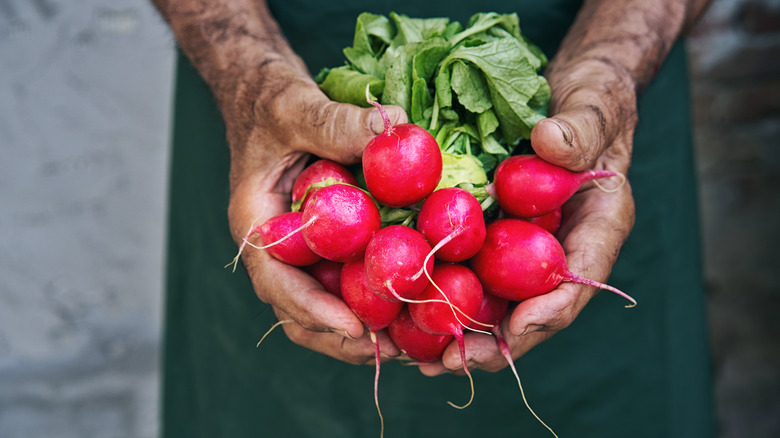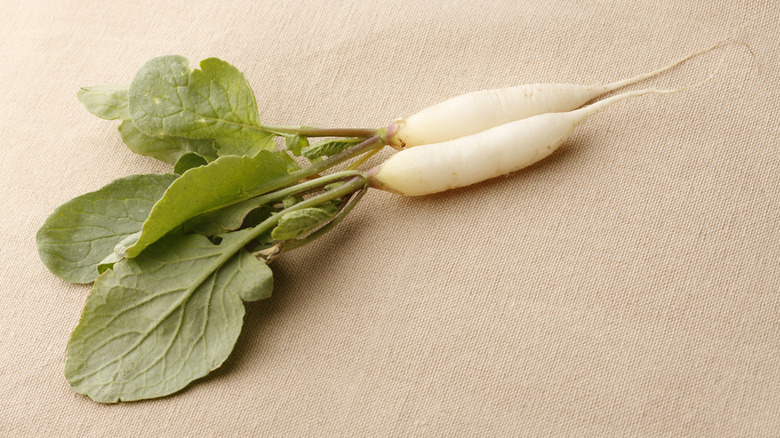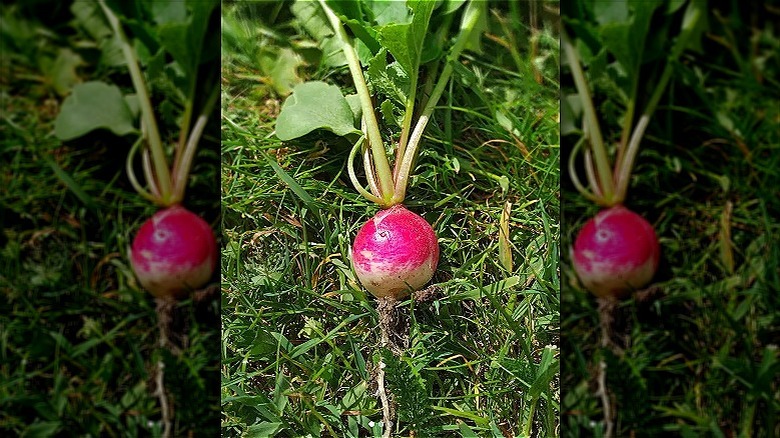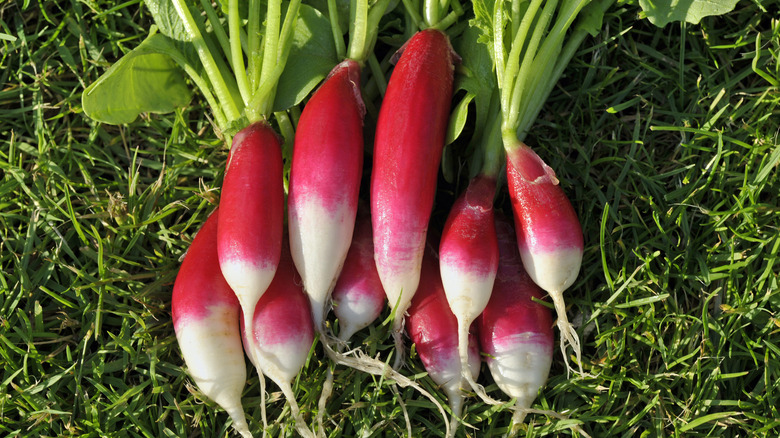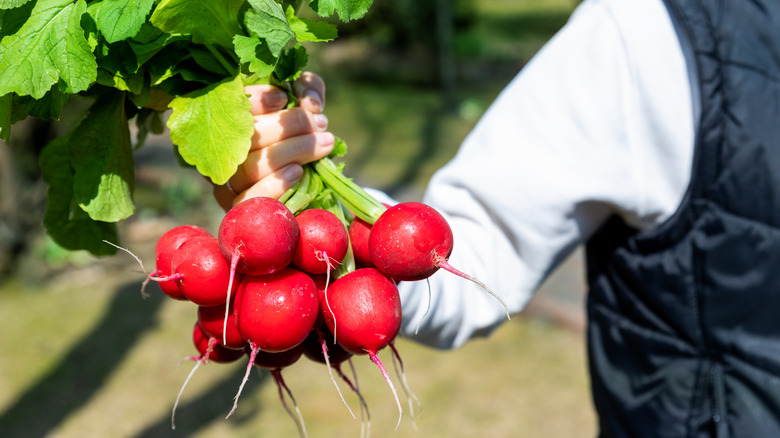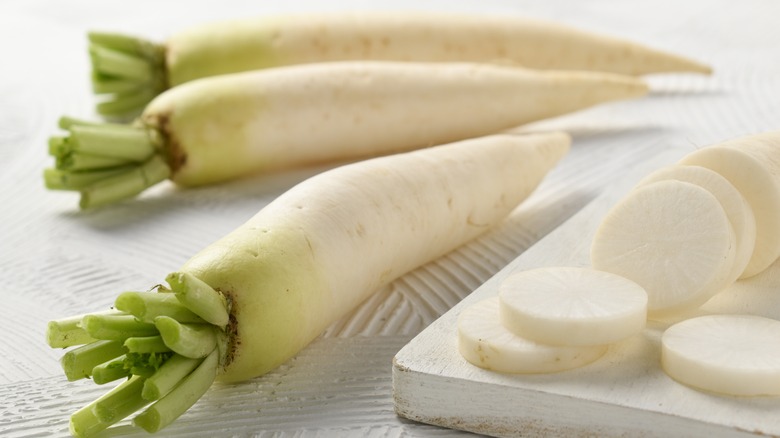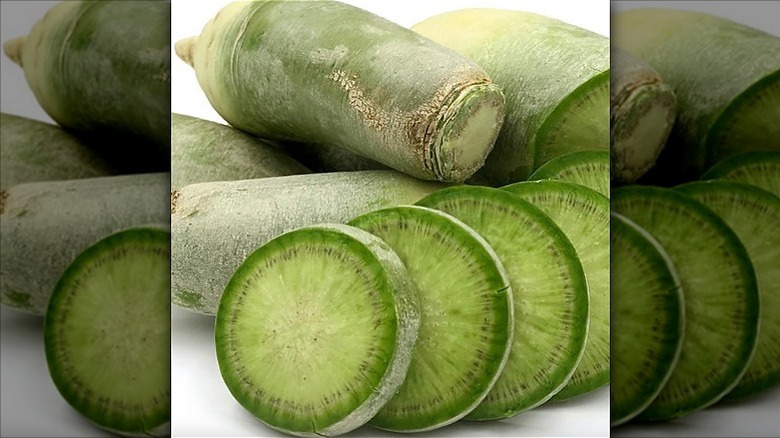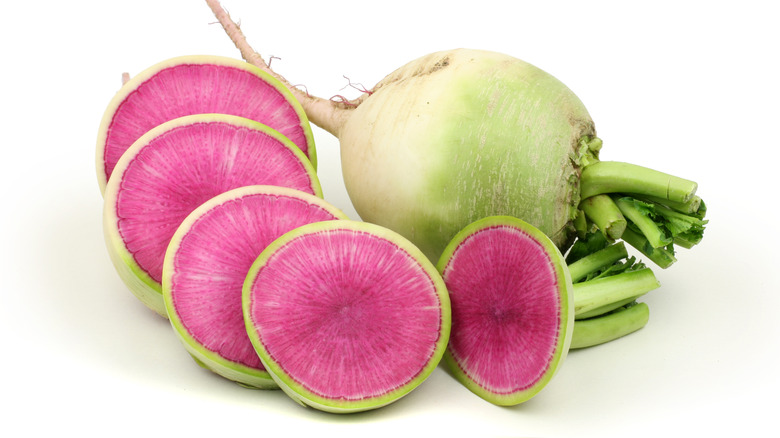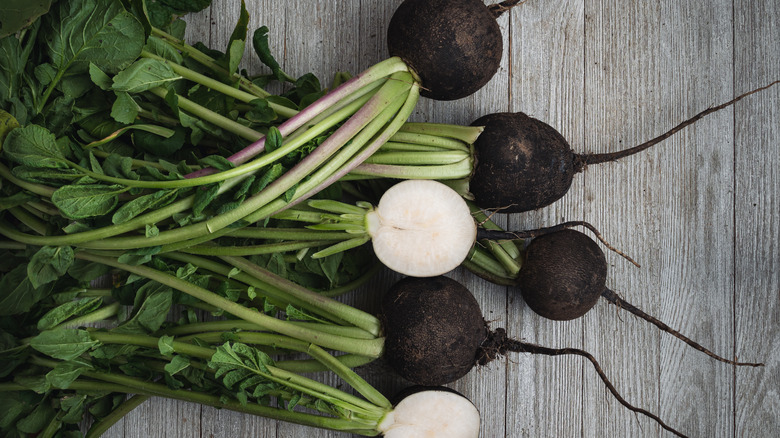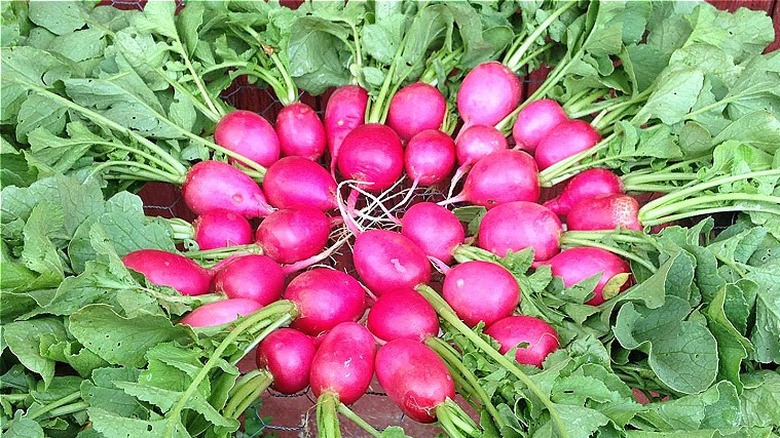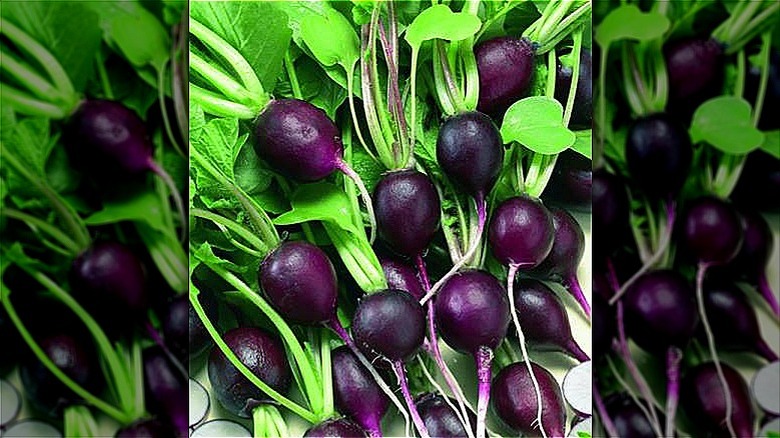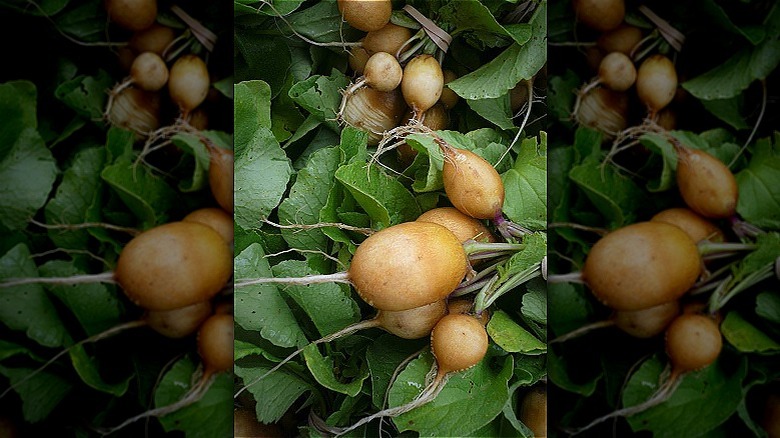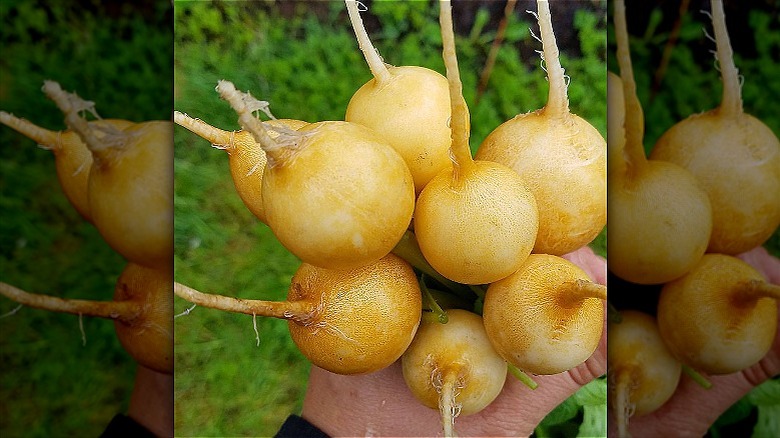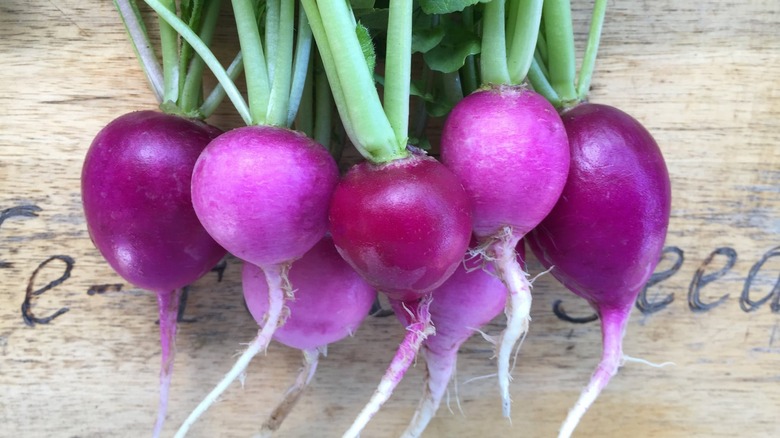14 Radish Varieties You Should Keep On Your Radar
The radish, or Raphanus sativus, can be traced back to ancient China. This vegetable has long been revered for its versatility across cultures from ancient Egypt to Europe to the New World, where its cultivation began in Mexico around 1500. Radishes are root vegetables, a member of the Brassicaceae family, which includes broccoli, cabbage, and kale.
They come in numerous sizes, shapes, and colors, ranging from white to pink to deep purple. Radishes can get divided into four basic types, including the Western type, ideal for salads; the oriental type, which is larger and milder; the leaf type, intended to feed livestock; and the rats-tail, grown for seed pods.
Radishes may not be the most well-known or utilized of vegetables, but they should be. It contains a high nutritional value, including significant amounts of vitamin C, potassium, folate, niacin, calcium, magnesium, zinc, phosphorus, copper, manganese, vitamin B-6, and vitamin K. It has purported anti-cancerous properties, antifungal properties, and potential to help to neutralize the toxic fungus Zearalenone, which has gotten linked with reproductive issues.
These crunchy vegetables can range in spiciness from mild to hot. They can get used in many kinds of recipes, raw and cooked, including pickles, stir-fries, salads, sandwiches, soups, roasts, dips, and slaws. While there are more types of radishes than we can mention, here are a few varieties you should keep on your radar the next time you visit a farmer's market or gourmet grocery store.
1. White Icicle
This heirloom variety of radish has a shape befitting its moniker. These are hearty, heat and pest-resistant radishes that can grow to their full size, which ranges between 4 to 8 inches long, within three to four weeks. Its skin is relatively thin with a firm textured flesh with just enough moisture to give it a juicy crunch when raw. Its flavor is redolent of the earth, with a flavorful but not overly aggressive spiciness. The leaves of these radishes are also edible.
The Icicle radish, which is an umbrella term for several different similarly shaped and colored radishes like White Naples, Icicle Short Top, White Italian, Lady Fingers, White Icicle, Long White, and White Transparent, is often grown in conjunction with squashes due to its property as a hindrance to squash bugs. The breed originated in Europe, where it was a popular addition to physics gardens. These gardens were established to research plants with suspected medicinal properties and often featured prominently at universities, monasteries, apothecaries, and wealthy estates, notably the Vatican.
Icicle radishes are ideal for virtually any culinary application, raw or cooked. When cooked, its texture tends to have similar characteristics to a potato. Its distinct flavor lends itself to potent herbs and spices characteristic of Asian cuisines of all kinds, as well as umami-forward ingredients like meat and mushrooms. The greens are delightful in a salad with bitter greens like arugula or radicchio.
2. Sparkler
Another radish that has aptly gotten named for its distinct coloring is the Sparkler radish. These two-toned beauties typically range from 1 to 1 ½ inches in diameter and have a long, gangly, hairy taproot. The fruit has a deep red, almost purple top fading to a white bottom that can have speckles with random pink sparkly dots. Sparkler radishes are milder radishes with a hint of sweetness, making them a favorite for a typical French crudité platter, served with delectable French butter and fleur du sel.
The fast-growing heirloom breed of radish is a member of the western radish category and often goes by names like White Tip and Sparkler White Tip. While these radishes can grow year-round, they are more palatable in cooler weather. While they can get consumed raw or cooked, they are better suited for recipes where they are raw. If cooked, it is ideal to use a slow cooking technique that encourages the natural sugars within the radish to caramelize to sweet perfection. This radish type can handle bold flavors like salty feta, tangy citrus fruits, bitter fennel, sour vinaigrettes, and umami-loaded bacon.
3. French Breakfast
Despite its name, the French Breakfast radish is generally not associated with the French at all. It is an heirloom breed of radish that first got documented in 1879 and became a breakfast staple in England during the Victorian Era spanning from 1837-1901, served with toast, watercress, and potted shrimp. This popular variety ranges from 2 to 4 inches long, with an oval shape, delicate skin, and a brilliant color combination of a salmon-hued top and a whitish bottom. Their texture is brittle and chewy, with a flavor that has bright spice and a mellow earthen undertone.
When cooked, this radish becomes milder, and its nutty caramelized sugars spring forward. Its leaves are brightly flavored and ideal for salads, added to an omelet, or stewed. In France, they became popular and added to a dish called radis beurre et pain grillé, or grilled bread and buttered radish. This radish also goes by Breakfast radishes, Flambeau, Flambo, Les Radis Petit Déjeuner, and Radis Demi-Long Rose a Bout Blanc.
This radishes' primacy in England gets illustrated by the annual Levens Radish Festival held in Cumbria, Northern England. From 1822 until the late 1880s, groups of up to 500 people would gather on May 12 to celebrate with raucous activities, including drinking games involving the famed Morocco Ale, a dark beer that has been the staple of Levens Hall for over 400 years. This festival was an attempt by the Lord of the Manor to curate favor among his stewards.
4. Early Scarlet Globe
When you go to the grocery store, you will typically find one type of radish for sale — the Early Scarlet Globe radish. This bright red, 1-inch-in diameter, round specimen of radish is perhaps one of the most widely recognized radishes. It has the quintessential radish profile — firm skin, succulent white flesh, crunchy bite, and a mild yet bright pepperiness that is perfect for salads, sandwiches, slaws, and crudité platters.
Per its name, this is a radish variety that reaches full size quickly in about 20 days. While it is ideally suited for cooler weather and wet soil, it is heartier than most varieties, doing well in warmer climates and greenhouses. It is known to have a lengthy shelf-life, making it ideal for longer-term storage in a root cellar.
The Early Scarlet Globe is a quintessentially American radish popping up in the 19th century. It was the radish of choice of Thomas Jefferson, who grew the variety in his gardens at Monticello. It first appeared in seed catalogs in 1885 before becoming a standard offering across New England.
One of our favorite ways of using the Early Scarlet Globe radish is in a classic Indian Raita recipe. The creamy yogurt paired with the slightly spicy and crispy radish is the perfect balance atop a seared salmon filet or crab cake. For an extra hint of flavor and crunch, garnish the dish with a pinch of Egyptian Dukkah.
5. Daikon Long White
Daikon radishes are large hearty winter radishes cultivated across the globe. It is central to Chinese, Japanese, Korean, Indian, and Southeast Asian culinary traditions. Its name translates to "great root" in Japanese and is often called Chinese turnip. Its origins are typically attributed to the Mediterranean, although evidence of its existence in China can get found as far back as the 3rd century B.C. There are over 100 distinct varieties of Daikon radish ranging in size, shape, and color, having names like Japanese radish, Chinese radish, Winter radish, Long White radish, and Asian radish.
Daikon is often white but may also be purple, green, or red. Its length can range from a modest 6 inches to a whopping 23 inches. This radish is relatively dense, making it hefty for its size. The skin is thin and edible but often peeled to reveal a white, sometimes fuschia, streaked flesh that is moist and snappy, with a hint of spiciness. Though the leaves also get consumed, the root is generally the star.
Daikon has long gotten eaten in Japan as a food that aids in the digestion and detoxification of the body. It is also often incorporated into various religious cleansing rituals. From a culinary perspective, the Daikon radish gets served raw either as a condiment or as part of Korean kimchi. It also makes its way into spring rolls, is pickled for Vietnamese banh mi, and baked into Chinese radish cake. When stir-fried or otherwise cooked, it yields a texture similar to creamy mashed potatoes.
6. Green Meat
The Green Meat radish, though similar in shape and application to the Daikon radish, is a distinctive variety characterized by its size, which ranges from 5 to 10 inches long and 2 to 3 inches in diameter. This delicate variety flourishes in the milder spring and fall months. Its thick skin has an unusual dual-colored hue, with its top having a slightly chartreuse color blending into an off-white bottom half. The inside has an outer darker green ring surrounding a central lime green flesh that can taste moderately spicy to hot depending upon its maturity when harvested.
This radish, also known as Green Luobo, Misato Green, Qing Luo Bo, and Chinese Green, first appeared in Northern China. It is the focal point of an annual festival in Qingdao in the Shandong Province, China. The Qingdao Radish Festival has been celebrated for over 600 years. It commemorates the tradition of consuming radishes on the 9th day of the Lunar New Year, which not only brings good fortune but purports to aid digestion and prevent the onset of respiratory ailments.
Like Daikon Radishes, the Green Meat radish is a popular condiment intended to help cleanse the palate after dishes with aggressive flavors. It is a favorite in Kimchi, commonly used in sushi rolls, and provides a beautiful color and crunch in sandwiches, tacos, and bao buns. It is also stellar in soups and stir-fries, where its pepperiness can be tamed and its crunchy texture mellowed.
7. Easter Egg
What could be a more entertaining Springtime harvest than a bunch of radishes that are perfectly round and brightly colored in hues of pink, scarlet, Fuschia, and white, resembling fancy decorative Easter eggs? The answer is nothing. These little beauties that are just over 1 inch in diameter are delightful. They share the mild, slightly piquant flavor of a classic Scarlet Globe radish in bite-sized portions.
While the cultivation of radishes may have been perfected across Asia, once these cultivars made their way to Europe, perfect globular-shaped radishes became the preferred varieties. By the time they got introduced to the New World, these orbital breeds expanded in popularity rapidly, with seed packets of colored radishes becoming all the rage by the 20th century.
As with other radishes, the Easter Egg radish can get served raw or cooked, although, if we are honest, we prefer them raw without a lot of fancy preparation. We thrill at seeing them on a platter on full display in their glorious colorful essence.
Now would be the time to go the traditional French route and serve your radishes with other fresh vegetables alongside a luscious homemade aioli. Try infusing your aioli with roasted garlic and garnish with some Za'atar seasoning. Alternatively, consider a roasted red pepper or spicy harissa-infused hummus garnished with zesty sumac.
8. Watermelon
The Watermelon radish is arguably one of the favorite radish varieties among chefs and food enthusiasts. This heirloom breed of radish is related to the Daikon radish and hails from China, where it is known as shinrimei or beauty in the heart. And this radish is just that, beautiful. Its name may insinuate it has the flavor of a watermelon, but instead indicates its interior bright raspberry color reminiscent of the inside of a red watermelon.
Though available year-round, this type of radish is best in the milder spring temperatures when its flavor is delicate with a spice similar to black pepper. Don't let its exterior fool you. At first glance, they may look like green potatoes, which can be toxic. But once you slice into them, they reveal their glorious flesh, which can get served raw or cooked. And don't peel them. Part of their charm is how you get the juxtaposition of the green peel against the claret flesh, making it look just like a mini watermelon.
If you plan to cook these radishes, consider roasting them whole, drizzled with a hint of olive oil, salt, and pepper. Their color will fade slightly but will still retain a lovely layered look. They are a clear favorite for slaws or pickles due to the pop of color they lend. Although for us, they shine best in salads with other brightly colored ingredients, like green kale, blueberries, blood orange segments, crunchy pistachios, salty feta cheese, and a bright vinaigrette.
9. Black Spanish
At first glance, the Black Spanish– or Gros Noir d'Hiver, Black Mooli, and Erfurter radish — looks like a lump of coal thanks to its charred-looking exterior. However, they are a rare heirloom variety of radishes generally not found outside of home gardens or farmer's markets. This sturdy cultivar was often grown in Europe during the colder months thanks to its hardiness.
Its origins go back to ancient Egypt, where it regularly served pyramid workers in need of sustenance. This varietal is considered valuable for its medicinal properties, which include the treatment of respiratory ailments, the prevention of bug bites, and regulating bile function, which can assist in gallbladder functioning.
There are two types of Black radish, a smaller one ranging in size from 3 to 4 inches long and a larger stretched-out one ranging from 7 to 8 inches long. Both types have dense white flesh that is aggressive in flavor, redolent of the earth, acrid, and extremely spicy.
This variety of radish is not ideal for raw applications, although it can get added to some dishes if peeled, as the skin is where most of its intense flavor resides. For the best results, roast, braise, fry, or sauté these radishes. Doing so will help caramelize the natural sugars in these radishes, taming their flavor and piquancy.
10. Pink Beauty
Among the most attractive radish varieties, the Pink Beauty has a gorgeous bubble gum coloring that makes it pop on a salad or crudité platter. This fast-growing radish is ideally suited to milder weather, making it a Spring or Fall radish. It's a perfectly round radish approximately 1 inch in diameter when ripe, has succulent white flesh, and a mild flavor that is slightly less aggressively spicy than other varieties.
This heirloom variety got cultivated in the Dutch and French traditions, which favored small globe radishes that were sweeter and more refined. This variety is eaten raw in virtually any format but is ideally suited for traditional Korean pink pickled radishes, which often get combined with beets for a brighter salmon hue.
Pink Beauty radishes would also be perfect for a rosy pink radish soup, which combines new potatoes and beets for a velvety bisque with gorgeous color. And finally, consider braising these radishes with shallots and bacon for a sweet and savory umami bomb that is pretty in pink.
11. Malaga Violet
Purple lovers rejoice! The Malaga Violet radish is one of the most spectacularly colored radish varieties. It has a deep violet hue, resembling a small beet in color and shape. Perfectly round and approximately 1 to 2 inches in diameter when at its ideal ripeness, this radish has a slightly milder flavor than others, making it perfect for salads, crudité platters, or other raw applications. Its white flesh is crisp and never mealy. Its leaves are ideal for harvesting as microgreens or as salad greens. They are a forgiving radish variety, tolerant of colder temperatures, and ready to harvest within 30 days.
This heirloom breed of radish was cultivated in Poland before making its way to the U.S. Because it is a lesser-known radish type, you won't likely find them outside farmer's markets. We recommend combining them with purple potatoes and roasting them for a delightful side dish your kids will love. As a bonus, like other purple vegetables, the purple radish is high in anthocyanins, an antioxidant responsible for making purple vegetables hardier. Anthocyanins are efficient anti-inflammatories, combatting ailments including cancer, diabetes, and arthritis.
12. Zlata
The Zlata radish is an heirloom breed of radish that first appeared in Eastern Europe around the 1700s. Its name, Slavic for "gold," is descriptive of its distinct color, which ranges from a yellowish hue that can be a lighter lemon to dark amber. These are relatively small, round radishes, about 2 inches in diameter. Their flavor is far less aggressive than their red cousins, making them ideal for those who dislike overly spicy foods.
This breed is a heat-resistant radish that won't bolt in the summer, making it suitable for growing from spring to fall. While the Zlata radish can get consumed in raw or cooked dishes, one recipe it commonly gets found in is the chilled summer soup hailing from Russia called okroshka. Okroshka has a base of sour cream combined with a carbonated fermented drink made from rye bread called Kvass.
Additional ingredients include sausage, dill, chives, green onions, eggs, cucumbers, potatoes, and radishes. This soup was served as a hearty lunch commonly eaten by barge workers along with dried fish. The best way to describe this dish is like a combination between gazpacho and tzatziki. The chopped vegetables provide this cold soup with abundant nutrition and visual appeal.
13. Helios
Another yellow-hued variety of radishes, the Helios, is a petite, oval-shaped radish with white flesh that is moist, crunchy, mild, and has a slight kick. These radishes always get harvested when young or may become mealy and aggressively acrid as they age. They are another variety of radishes well suited to warmer climates, making them a favorite heirloom varietal in countries like Australia.
This radish, whose moniker got inspired by the titan god Helios of Greek mythology, is named for its flaxen hue similar to that of the sun. It is a radish that first appeared in Kosice, Czechoslovakia, around 1700. Like other yellow varieties, scientists believe this radish is a mutation of the red radish, lacking in the gene responsible for expressing the typical bright red radish hues.
Because of its diminutive size, this type of radish is often eaten raw. In Czechoslovakia, it gets shredded into a softened cheese similar to cream cheese and mixed with butter, chives, and salt before being spread on toast points. It is also braised, or roasted, with other root vegetables, where it gets even sweeter and more tender. And while its greens can be potent, they make a great addition to pesto or hummus for a kick of heat.
14. Purple Plum
The Purple Plum radish is a distinctly American breed of radish first cultivated in Mount Vernon, Washington, by the American seed company Alf Christianson Seed Company, in 1985. This relatively recent cultivar was developed for its mild flavor, ability to resist heat, resistance to bolting, and speedy life cycle. While it first appeared in seed catalogs in the Pacific Northwest, it is now available across the U.S.
This lavender-colored small radish variety ranges from round to slightly oblong. It has firm, white flesh that becomes tender when cooked. They are sometimes known as table radishes and, like other purple vegetables, are loaded with anthocyanins, antioxidants known for their substantial anti-inflammatory properties.
While these certainly can be eaten raw, taking advantage of their beautiful color, they get marvelously cooked in omelets, casseroles, soups, stews, curries, and stir-fries, where their inherent sweetness can caramelize into nutty perfection. To enhance their flavor, add honey or maple syrup to coax their sweetness out even further. This variety of radishes is also ideally suited to being blanched and frozen for longer-term storage. They should be kept for approximately one month in a freezer bag with all the air removed.
